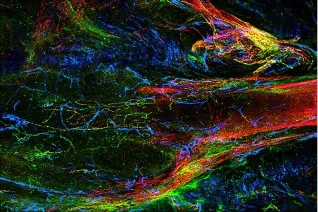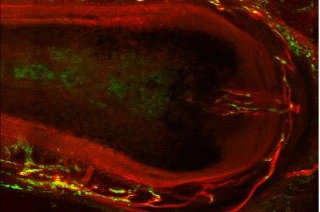When Marna started her position in dermatology, she realized that she needed to augment her academic training in botany and plant physiology with a better understanding of the animal (and human) side of the equation. Fortunately, she has never been shy (or “maybe even a little obnoxious”) about asking others for help to learn the things that she needs to move forward. This fervent curiosity fostered strong skills in hard-core protein biochemistry and expertise in advanced microscopy imaging techniques (confocal, multiphoton, second harmonic generation, EM). Over the years, she processed a plethora of skin, hair, and cancer samples and developed a reputation for being able to do nice imaging and making collegial connections throughout the university, including entomologists with interests in tick-borne diseases. These connections proved to be invaluable when her teenage son fell ill and was eventually diagnosed with a vector-borne disease and offered the impetus to redirect her research toward the relationship between vector-borne disease and skin.
“…a lot of the researchers studying vector-borne infections have some kind of personal tie: either they had it, a parent had it, or a loved one had it. For me, it was my son. When he was fourteen, he got very, very ill. A colleague of mine had heard a talk by a veterinarian at a meeting about Bartonella, an infectious bacterial agent, and the effects of cat-scratch disease. And she said, ‘…it sure sounds like what your son has.’ At that point, I had literally been to fifty doctors with my son, and no one had a clue…So I called that vet, had my son’s blood sample analyzed, and soon learned that it was screaming hot with Bartonella…that is what drew me into the field.”
Vector-borne infections that can be transmitted to humans and other animals by mosquitoes, ticks, and fleas are becoming more common. Traditionally, malaria has garnered a majority of the limited government funding for vector-borne disease research. Now, adding the emergent priority of COVID-19, it has become harder to find support for the Borrelia, Bartonella, and Babesia studies that interest Marna. Funding instead comes from philanthropic organizations and special initiatives, like the Steven and Alexandra Cohen Foundation, the Global Lyme Alliance, and collaborative partnerships like the One Health Initiative, which relies on the expertise of scientific researchers, physicians, nurses, veterinarians, epidemiologists, and related professions. The Cohen Foundation supports her research on Tissue Analysis: Improving Detection and Understanding Pathogenesis in Lyme and Tick-borne Disease.
“I started looking for Bartonella, and I found it repeatedly in the skin, seeming to be associated with the collagen fibrils in the dermis. I strongly believe…that the skin may act as the primary reservoir for these bacteria., and because they cluster into biofilms, they become metabolically inactive and unresponsive to typical intervention. Antibiotics, which typically work on an enzymatic process—like building a cell wall—are ineffective when the bacteria are dormant…We’re in the infancy of understanding the impact of biofilms and how they can modify the response of antibiotics.”
The work being done by Marna and her collaborators has framed a new picture of what happens to an infectious agent thought originally to affect only the blood and how it can produce other untoward effects throughout the body in short- and long-term scenarios. It becomes essential to understand how to target and disrupt the bacteria that cluster into biofilms as a means to improve treatment options for persistent vector-borne diseases and to learn more about the role that these pathogens may play in other diseases. Recently, Marna and others have found Bartonella in human melanoma lesions, which adds studying the potential implications of pathogens on cancer to her “to-do” list. Other list items include her plan to create reliable diagnostics, advance the understanding of persistent infections, and foster the relationships needed for insightful, collaborative solutions.










